ABSTRACT
A study conducted at Nasugbu East Senior High School explored the production and market acceptance of papaya chips. The research targeted 42 teachers, utilizing a descriptive design to gather data. Findings indicated papaya chips offer health benefits, vitamins and a unique taste profile.
Respondents overwhelmingly expressed satisfaction with the product, citing exceptional quality. Papaya chips exceeded consumer expectations, positioning them as a desirable alternative to traditional chips. The nutritional value and taste appeal make papaya chips an attractive option.
The study recommends recognizing papaya chips as a viable food product, integrating papaya into commercial cooking recipes, and incorporating papaya into TVL Commercial Cooking students' recipes. These findings encourage further exploration of papaya-based products, potentially revolutionizing the snack food industry.
INTRODUCTION
Papaya, also known as the “tree melon” (Carica), is a tropical fruit rich in vitamins A and C as well as other important nutrients like potassium, beta-carotene, and lycopene. It’s a nutritious choice for any meal plan, and it may offer health benefits like reduced inflammation, slowed Alzheimer’s progression, healthy digestion, and cancer prevention. We can also innovate papaya into a creative food item, like chips.
According to Schwiggert et al., 2011; USDA (2020), Papaya fruit (Carica) was selected as a model fruit because it Is a valuable source of lycopene and pro-vitamin A carotenoids.
Likewise, Annegowda and Bhat (2016), Papaya Chips are of a nutritional quality than traditional fried snacks. This process is performed at pressures below atmospheric levels, which decreases the boiling points of the frying oil and the water in the product.
Furthermore, Pandey and Chauhan (2019, reported that after frying the texture of various products such as fruits and vegetables is majorly related to internal properties likewise, size of cell, its surface area, specific gravity and starch content, pectin content and total solids.
In addition, Da Silva and Moreira (2008), the consumer trends towards healthier foods require alternative strategies to the consumption of traditional fried snacks, which are rich in simple sugars, saturated lipids, and salt. The manufacturing of fried chips based on fruits having good nutritional and sensory properties represents such an alternative.
Researchers from Nasugbu East Senior High School aim to explore the possibility of creating and selling Papaya Chips. The following questions will be attempted to be addressed:
a.) What are the nutritional benefits of Papaya Chips compared to other traditional chips options?
b.) What is the market acceptance and consumer preference for Papaya Chips in terms of: 2.1 taste; 2.2 price; 2.3 overall willingness to purchase?
c.) How can TVL Commercial Cooking effectively incorporate Papaya into Chips recipes?
The researchers employed descriptive research design for the purpose of determining Papaya Chips’ market acceptance and consumer preference among different consumers at Nasugbu East Senior High School. The findings were the basis for creating a recipe that will provide insightful observation into the production and market acceptance of Papaya-incorporated chips, laying the foundation for a successful product launch.
METHODOLOGY
The study adopted a descriptive research design with a quantitative approach, exploring the feasibility and potential impact of introducing “Papaya Chips”. According to McCombes (2023), Descriptive research aims to accurately and systematically describe a population, situation or phenomenon. It can answer what, where, when and how questions, but not why questions.
The study was conducted in Nasugbu East Senior High School, located at Brgy. Lumbangan, Nasugbu, Batangas. The school has been founded in 2016 headed by Principal II, with fifty-one (51) teachers and five (5) non-teaching staff. To ensure representative samples, the researchers selected 42 Teachers as respondents using Slovin’s formula. Slovin’s formula is used to calculate the sample size necessary to achieve a certain confidence level of 95 percent and Precision Level or margin of error of 5 percent. After thorough study of the problem, the respondents were chosen using Simple Random Sampling (SRS) which involves selecting individuals from the population in such a way that every individual has an equal chance of being chosen. This sampling method has an equal and likely possibility of getting selected in the sample. Since the selection of item completely depends on the possibility, therefore this method is called “Method of chance Selection”.
Data collection primarily relied on a survey questionnaire administered to the selected TVL Teachers. This questionnaire included both close-ended and Likert scale questions, covering aspects such as awareness of health benefits, overall willingness to purchase a product, and feedback on products’ taste and price.
Ethical considerations, such as informed consent, confidentiality, and voluntary participation, were strictly adhered to throughout the research process.
To analyze the feasibility study of the product and collection data, the researchers conducted the survey through direct dissemination of the questionnaires. The questionnaire design includes a cover letter explaining the study’s purpose and ensuring strict confidentiality between researchers and respond.
The Likert scale questions were coded and analyzed using descriptive statistics, including percentages, weighted means, and standard deviation. The findings were presented through tables, facilitating further analysis and comparison.
RESULTS and DISCUSSION
This part presents the data gathered, analyses and interpretation to answer the problem which this study aims to achieve.
1. The Nutritional Benefits of Papaya Chips compared to traditional chips options
Table 1 presents the Nutritional benefits of the respondents in terms of Health consideration. Based on the ten (10) indicators which are presented to the respondents during the conduct of the survey, the highest Weighted Mean is the respondents’ answers regarding of health consideration with weighted mean of 3.92 (SD=3.40), qualitatively describes as Strongly Agree. This means that Papaya has nutritional content which is an important factor in the decision to consume Papaya Chips. However, Papaya Chips have ingredients that align with health-concious choices, also Papaya Chips considered a healthier alternative to traditional chips ingredients and has potential health-related advantages compared to other similar products has the lowest weighted mean of 3. 83 (SD=3.31) which means respondents appreciate the ingredients. This indicator is qualitatively described as Strongly Agree.
Overall results show that the respondents mark “Strongly Agree” on the health consideration of Papaya Chips with grand weighted mean of 3.9 (SD=3.36).
This result is related to the study conducted by Hsieh and Huang (2020) who revealed that multimedia input combined standard accent seems more effective for the development of listening skills. This explained that additional instructional materials should be utilized to develop their listening comprehension.
Table 1 The Nutritional Benefits of Papaya Chips compared to other traditional Chips options
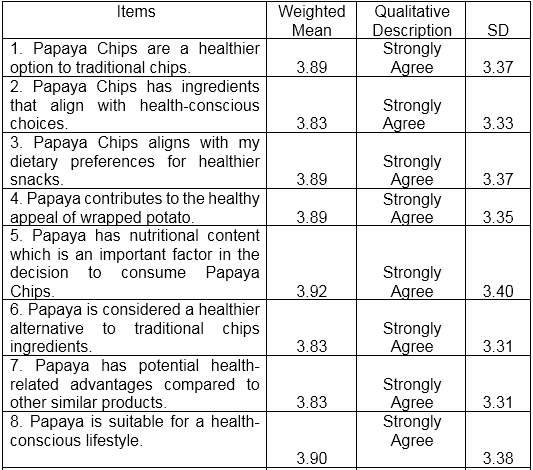
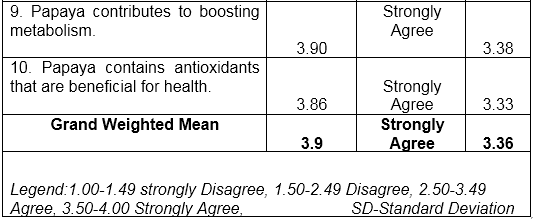
2. Market Acceptance and Consumer Preference for Papaya Chips in terms of:
2.1 taste Table 2 presents the market acceptance and consumer preference of the respondents in terms of taste. Based on the five (5) indicators which are presented to the respondents during the conduct of the survey, the highest Weighted Mean is the respondents’ answers regarding Papaya Chips have a pleasant taste with weighted mean of 3.85. (SD=3.44), qualitatively describes as Strongly Agree. This means that they are pleasant with our chips. However, Papaya Chips taste better than traditional chips has the lowest weighted mean of 3. 73 (SD=3.24) which means respondents still appreciate the taste of our traditional chips. This indicator is qualitatively described as Strongly Agree.
Overall results show that the respondents mark “Strongly Agree” on the taste of Papaya Chips with grand weighted mean of 3.80 (SD=3.32).
This result is related to the study conducted by Hsieh and Huang (2020) who revealed that multimedia input combined standard accent seems more effective for the development of listening skills. This explained that additional instructional materials should be utilized to develop their listening comprehension.
Table 2 Market Acceptance and Consumer Preference for Wrapped Potato in terms of Taste
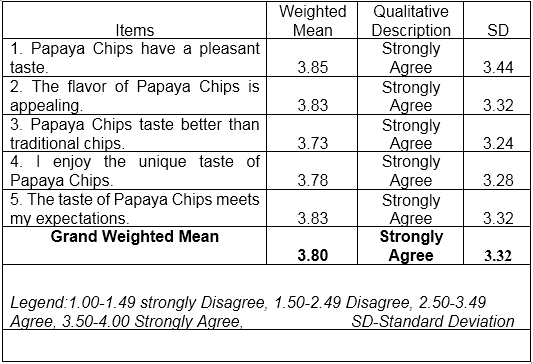
2.2 Price
Table 3 presents the market acceptance and consumer preference of the respondents in terms of price. Based on the five (5) indicators which are presented to the respondents during the conduct of the survey, the highest Weighted Mean is the respondents’ answers regarding the pricing of Papaya Chips with weighted mean of 3.85 (SD=3.34), qualitatively describes as Strongly Agree. This means that the pricing for Papaya Chips is competitive. However, the willingness to pay a premium for Papaya Chips by the respondents has the lowest weighted mean of 3.78 (SD=3.28) which means respondents valued their money. This indicator is qualitatively described as Strongly Agree.
Overall results show that the respondents mark “Strongly Agree” on their listening competencies in English with grand weighted mean of 3.81 (SD=3.31).
This result is related to the study conducted by Hsieh and Huang (2020) who revealed that multimedia input combined standard accent seems more effective for the development of listening skills. This explained that additional instructional materials should be utilized to develop their listening comprehension.
Table 3 Market Acceptance and Consumer Preference for Wrapped Potato in terms of Price
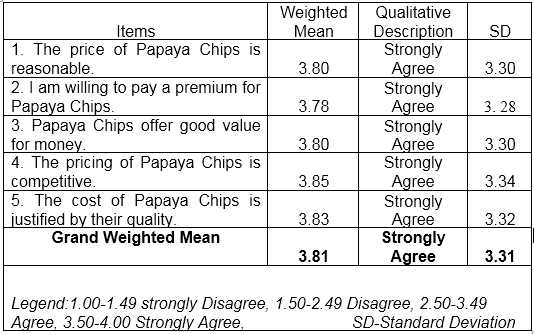
2.3 Overall willingness to purchase
Table 4 presents the market acceptance and consumer preference for Papaya Chips in terms of the willingness to purchase. Based on the five (5) indicators which are presented to the respondents during the conduct of the survey, the highest Weighted Mean is the respondents’ answers regarding likely to purchase Papaya Chips again with weighted mean of 3.86 (SD=3.34), qualitatively describes as Strongly Agree. This means that Papaya Chips is deserving to purchase. However, Papaya Chips are a preferred choice, satisfied with the overall experience of Papaya Chips and a desirable product has the lowest weighted mean of 3.81 (SD=3.30) which means respondents appreciate the Chips. This indicator is qualitatively described as Strongly Agree.
Overall results show that the respondents mark “agree” on their listening competencies in English with grand weighted mean of 3.82 (SD=3.32).
This result is related to the study conducted by Hsieh and Huang (2020) who revealed that multimedia input combined standard accent seems more effective for the development of listening skills. This explained that additional instructional materials should be utilized to develop their listening comprehension.
Table 4 Market Acceptance and Consumer Preference for Wrapped Potato in terms of Overall Willingness to Purchase
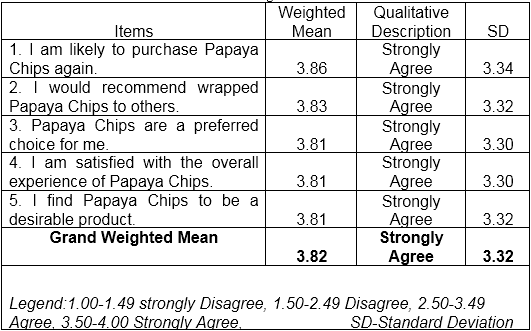
3. Market Effective Incorporation of Papaya Chips into Recipes by TVL Cookery Students
Table 5 presents the Market Effective Incorporation of Papaya Chips into Recipes by TVL Cookery Students. Based on the five (5) indicators which are presented to the respondents during the conduct of the survey, the highest Weighted Mean is the respondents’ answers regarding the easiness to incorporate Papaya Chips into recipes and enhancing the overall taste of Chips with weighted mean of 3.93 (SD=3.40), qualitatively describes as Strongly Agree. This means that Papaya is a deserving Chips to create. However, Papaya can be used as substitute for less healthy ingredients and has the lowest weighted mean of 3.90 (SD=3.35) which means respondents acknowledge Papaya. This indicator is qualitatively described as Strongly Agree.
Overall results show that the respondents mark “agree” on their listening competencies in English with grand weighted mean of 3.9 (SD=3.33).
This result is related to the study conducted by Hsieh and Huang (2020) who revealed that multimedia input combined standard accent seems more effective for the development of listening skills. This explained that additional instructional materials should be utilized to develop their listening comprehension.
Table 5 Effective Incorporation of Papaya Chips into Recipe by TVL Cookery Students
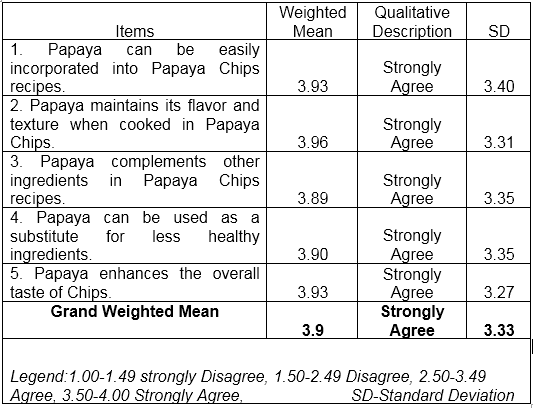
Conclusions and Recommendations
This section presents conclusions and recommendations for the study.
CONCLUSIONS
Based on the findings of the study, the following conclusions are drawn:
1. Respondents strongly agree on the nutritional benefits of papaya chips.
2. Papaya chips offer a more nutritious alternative to traditional chips, providing a good source of vitamins, minerals, and antioxidants with lower calorie and fat content.
3. TVL commercial cooking students can contribute to the growing market for papaya chips by developing innovative and appealing recipes that cater to consumer preferences and highlight the nutritional benefits of this healthy snack option.
4. Papaya have gained market recognition and consumer preference in terms of taste, cost, and general readiness to buy, and it is suggested to be used in papaya chip recipes.
RECOMMENDATIONS
Based on the proceeding findings and conclusions the following recommendations are offered by the researchers:
1. For a healthy chip option, papaya should be added to papaya chip recipes.
2. Papaya chips should be accepted and acknowledged by the market as a component of several food items for the benefit of consumers.
3. Papaya chips should be incorporated into recipes by TVL Commercial Cooking Students.
4. Papaya chips should focus on marketing to health-conscious consumers, individuals seeking healthier snack options, and those with dietary restrictions.
5. Papaya chips should known for their crunchy texture and sweet flavor and provide multiple options including local and international brands.
6. Papaya chips should be marketed as a healthier alternative to traditional chips, emphasizing their higher vitamin, mineral, and antioxidant content while being lower in calories and fat.
BIBLIOGRAPHY
1. Annegowda and Bhat (2016). Effects of chemical treatments on fresh-cut papaya. Food Chemistry. 190, 1182–1189. https://doi.org/https://doi.org/10.1016/J.FOODCHEM.2015.06.038
2. Jones (2024) Health Benefits of Papaya. https://www.medicalnewstoday.com/articles/275517 3. McCombes (2023) Definition of Descriptive research design. https://www.google.com/url?sa=t&source=web&rct=j&opi=89978449&url=https://www.scribbr.com/methodology/descriptive-research/&ved=2ahUKEwi97uOytbiIAxVxr1YBHb6_KcYQFnoECC4QAQ&usg=AOvVaw2RKGRgUGq9Obj633Tn2ZeM
3. Sharma (2020). Papaya based processed food and beverages. https://www.researchgate.net/figure/Papaya-based-processed-food-and-beverages_fig2_345487969
RECIPE
Ingredients:
Unripe Papaya
Rice
Salt
Onion powder
Garlic powder
Hot water
Black pepper
Procedures:
1. Steam papaya for 1hr.
2. While steaming papaya, cook the rice.
3. When the rice is done, put it into a blender, then add the condiments. Add hot water, then blend it.
4. Once the papaya is done, add it into the blender.
5. When the mixture is smooth and thick, spread it into parchment paper, and then directly dry it into sunlight in 1 to 2 days.
6. After drying the mixture, kindly take it out into parchment paper, and then pride it until in turn into light brown.